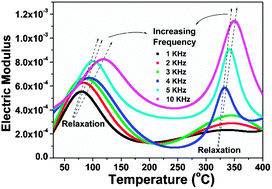Strong interfacial polarization in ZnO decorated reduced-graphene oxide synthesized by molecular level mixing
Abstract
Globally, there is a great demand for energy storage materials and devices. In this context, charge storage capacitors are of great prominence. Metal oxide–graphene composites are excellent candidates for charge storage materials. This is because the dielectric properties of these composites can be controlled by the nature, dimensions and spatial distribution of the conductive components in these composites. ZnO decorated reduced-graphene oxide (r-GO) is synthesized and studied in this context. ZnO–r-GO composites are synthesized using molecular-level mixing. The composites are named as ZnO-0.1G, ZnO-0.2G and ZnO-0.3G in the order of increasing r-GO content. At 1 kHz, the dielectric permittivity (ε′) values of ZnO-0.1G, ZnO-0.2G and ZnO-0.3G are nearly 11 (ε′ = 114), 15 (ε′ = 153) and 40 (ε′ = 400) times greater than that of ZnO (ε′ = 10). The strong interfacial polarization (Maxwell–Wagner polarization) in these composites is attributed to the presence of functional groups (which are polar in nature) on the r-GO sheets and also to the presence of lattice and/or topological defects in the r-GO. Temperature dependent electric modulus (M′′) studies further confirm the observed interfacial polarization.


 Please wait while we load your content...
Please wait while we load your content...